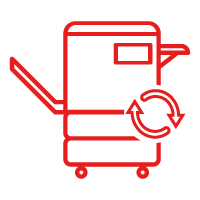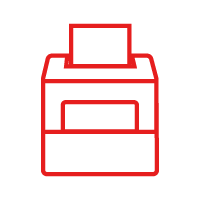-
Industry
SolutionsIndustry
SolutionsTeam with a technology partner that delivers across all industries.
Read more about industry solutions -
Software
SolutionsSoftware
SolutionsLearn how to optimise your business processes to save time and increase productivity.
Read more about software solutions -
Services
-
Products
Products
Feel confident knowing your technology will deliver reliability and longevity as you move forward.
Read more about productsMultifunctionEnhance your operational and financial performance with Toshiba's award-winning range.
Read more about multifunction Software
SoftwareSave money, better manage documents, secure critical information and improve efficiency.
Read more about software Pre-Owned MFDs
Pre-Owned MFDsQuality pre-owned A3 Multi-Function Devices (MFDs) fully refurbished by master manufacturer-trained technicians.
Read more about refurbished MFD Barcode Printer
Barcode PrinterToshiba Auto-ID, Barcode and Label printers are the perfect solution for everyday business.
Read more about barcode printer Printers
PrintersDesigned to deliver power and performance to small businesses and workgroups.
Read more about printers Interactive Flat Panels
Interactive Flat PanelsCreate inspired learning and smarter corporate collaboration
Read more about IFPs
-
Support
Support
We are here to help! Discover and access information about your Toshiba products or simply contact us for priority service.
Read more about support -
Company
Company
Toshiba is the world's most trusted provider of industry-targeted solutions that help increase the value of ideas and information.
Read more about company
 As schools in Australia continue their digital transformation journey, ICT managers face an evolving landscape of document and print management. The shift toward cloud-based workflows, an increasing need for vigilant security, the continuing focus on sustainability initiatives and ever greater integration is reshaping how schools handle documents, scanning, and printing.
As schools in Australia continue their digital transformation journey, ICT managers face an evolving landscape of document and print management. The shift toward cloud-based workflows, an increasing need for vigilant security, the continuing focus on sustainability initiatives and ever greater integration is reshaping how schools handle documents, scanning, and printing.
In this article, we take a look at four key trends for schools in 2025 and some of the ways they are harnessing the power of technology to address the challenges these trends present.
1. Cloud-based and mobile printing
As learning environments become more flexible, students and staff expect to print from a variety of devices, including BYOD laptops, tablets, and smartphones. Schools therefore need to consider how they will deliver location-independent printing with secure authentication, cost tracking and integration with school networks. Solutions such as Toshiba’s e-BRIDGE Global Print are helping schools around Australia to manage this challenge. For example, if the school has staff who are working from a remote location and want to print to the school’s print device, the e-BRIDGE solution gives them secure printing from any location, enhancing productivity and efficiency, regardless of work location. Users can easily send print jobs to the cloud, and safely and securely retrieve documents as they need them.2. Document security and compliance
With increased digitisation comes a greater responsibility to protect sensitive school data. Schools must comply with the Privacy Act 1988 (Cth) and the Australian Privacy Principles (APPs), which demand strict security measures for handling student and staff records.
In order to meet their obligations, schools need to ensure they have robust security at three levels – device security, access security and document security.
- Device Security can be implemented through features such as self-encrypting hard drives. Toshiba MFDs, for example, have functionality that automatically erases every print and scan immediately after every job, preventing data from being recovered by unauthorised users.
- Access Security allows the school to lock down access to a device in conjunction with windows active directories, enabling administrators to control access at the device in the same way it is controlled from the desktop.
- Document Security – schools can ensure that information on printed documents remains secure by requiring a password at the MFD and additionally applying a security stamp to all documents copied or printed, providing traceability.
3. Print sustainability
Sustainability is a growing priority in Australian schools, often driven by pupils’ demands as well the school leadership. 2025 sees more and more schools implementing strategies to reduce their use of paper and toner, eliminate paper waste and lower the environmental impact of their operations. The technologies that schools are embracing include:
- Follow me and print release – eliminates unnecessary printing (for example, after a ‘I don’t need to print that after all’ decision) by only releasing the print job once the user specifically requests it at the device.
- Enforced printing rules – for example, the school can mandate that all pages are printed on both sides, reducing paper usage.
- Chargeback – charging each department focuses them on their print usage and will often help to reduce it
- Eco-friendly ink – ink made from renewable resources, like soy or water, minimises environmental impact, reducing reliance on non-renewable resources.
- Toner recycling – avoids sending used toner cartridges to landfill.
- Analytics and reporting – insights into printing habits helps schools to design strategies to reduce print usage.
- Carbon neutral MFDs – schools can select an MFD supplier such as Toshiba that offers an option to purchase a device that is certified carbon neutral. Toshiba achieves this through first reducing the carbon footprint of the production process and then offering participation in a reforestation program to offset the remaining emissions.
- Offset paper usage – alongside providing carbon neutral devices, Toshiba offers the Print ReLeaf program, which helps schools to calculate and offset their paper usage, through reforestation programmes.
4. Integration with Learning Management Systems (LMS)
Modern document management is becoming more integrated with LMS platforms, reducing the need for standalone file storage. Schools that leverage LMS-driven document workflows experience:
- More efficient assignment distribution and collection.
- Reduced reliance on email attachments and printed materials.
- Streamlined access to educational resources across multiple devices.
For IT managers, ensuring smooth integration between LMS and document management systems is crucial for maximising efficiency and minimising administrative overhead.
Toshiba’s Kōdo and e-BRIDGE Plus suite of apps allow schools to scan to scan hardcopy documents into workflows and store documents in the Cloud (including Google, AWS, Dropbox and SharePoint). Users can connect directly to business applications to simplify everyday work tasks with one-touch process automation. Toshiba’s apps enhance productivity, save time and enable business transformation.
Preparing for the Future
The evolving landscape of document and print management presents both challenges and opportunities for school IT managers. By embracing cloud-based workflows and printing, strengthening security protocols, prioritising sustainability, and ensuring full integration with document management platforms, schools can create a more efficient, cost-effective, and future-ready environment for students and staff alike.
As 2025 unfolds, schools that proactively adapt to these trends will be better positioned to handle the increasing demands of digital education. The question is no longer whether schools should evolve their document and print management strategies - but how quickly they can implement the changes needed to stay ahead.
